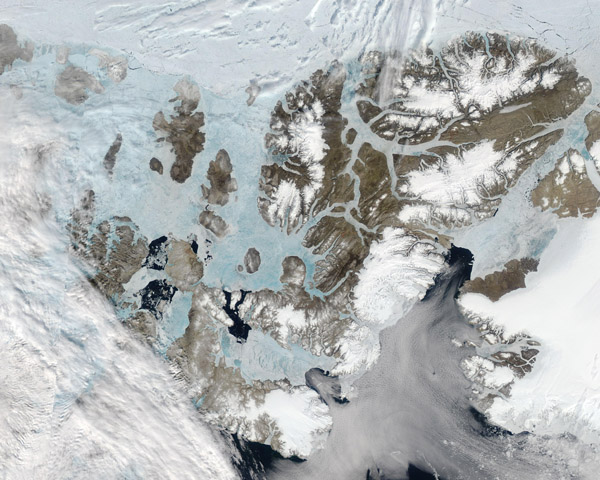Images
June 29, 2020 - Ice arch in the Nares Strait
Tweet
Arctic Sea ice persisted in far northern Canada in late June 2020, including the important “ice arch” that grows each winter in the Nares Strait between Ellesmere Island, Canada and western Greenland. The upside-down “u” shape of the southwestern edge of the arch can be seen close to the right edge of the image, spanning the strait between Ellesmere Island (west) and Greenland (east). The bluish-white leading edge of the arch stands out in vivid contrast to the inky-colored open waters of the Nares Strait.
This ice arch is natural gatekeeper, preventing sea ice from exiting the Arctic Ocean and drifting southward into Baffin Bay. The Arctic Ocean is considered a semi-enclosed ocean, as it is surrounded almost entirely by land. The northern coastlines of these land masses—Eurasia, North America, Greenland—and some scattered islands keep most of the sea ice penned up, making it less mobile than sea ice that forms around Antarctica. There are a few passageways that allow ice to escape in the spring and summer.
Although the Nares Strait is relatively narrow, a strong southward-flowing current through the strait ensures plenty of Arctic sea ice is lost there each year. As the ice arch forms, this flow of surface sea ice is halted and more ice stays within the Arctic Ocean. The ice arch typically melts between June and July. In 2019, the ice arch collapsed early, beginning to crumble in April. Early breakups were reported in 2017, 2010, and 2008. In 2007, the arch failed to form at all.
Despite warm temperatures over most of the Arctic this winter, and despite the extent of Arctic sea ice hitting the fourth-lowest on record in May of this year, the ice arch remained intact in late June. The light blue tint of the ice arch suggests that the ice has thinned and is becoming wet as it melts. It doesn’t appear to be quite as wet and thin as the fingers of ice on the shores and between Canadian islands, but bits of dark open water at the coast of Ellesmere Island and very dark ice off of Greenland suggest that collapse should occur shortly.
The Moderate Resolution Imaging Spectroradiometer (MODIS) on board NASA’s Terra satellite acquired a true-color image of Ellesmere Island, Canada, Greenland, and the ice arch spanning the Nares Strait on June 25, 2020.
Image Facts
Satellite:
Terra
Date Acquired: 6/25/2020
Resolutions:
1km (406.1 KB), 500m (1.1 MB), 250m (6.7 MB)
Bands Used: 1,4,3
Image Credit:
MODIS Land Rapid Response Team, NASA GSFC
Tweet
Arctic Sea ice persisted in far northern Canada in late June 2020, including the important “ice arch” that grows each winter in the Nares Strait between Ellesmere Island, Canada and western Greenland. The upside-down “u” shape of the southwestern edge of the arch can be seen close to the right edge of the image, spanning the strait between Ellesmere Island (west) and Greenland (east). The bluish-white leading edge of the arch stands out in vivid contrast to the inky-colored open waters of the Nares Strait.
This ice arch is natural gatekeeper, preventing sea ice from exiting the Arctic Ocean and drifting southward into Baffin Bay. The Arctic Ocean is considered a semi-enclosed ocean, as it is surrounded almost entirely by land. The northern coastlines of these land masses—Eurasia, North America, Greenland—and some scattered islands keep most of the sea ice penned up, making it less mobile than sea ice that forms around Antarctica. There are a few passageways that allow ice to escape in the spring and summer.
Although the Nares Strait is relatively narrow, a strong southward-flowing current through the strait ensures plenty of Arctic sea ice is lost there each year. As the ice arch forms, this flow of surface sea ice is halted and more ice stays within the Arctic Ocean. The ice arch typically melts between June and July. In 2019, the ice arch collapsed early, beginning to crumble in April. Early breakups were reported in 2017, 2010, and 2008. In 2007, the arch failed to form at all.
Despite warm temperatures over most of the Arctic this winter, and despite the extent of Arctic sea ice hitting the fourth-lowest on record in May of this year, the ice arch remained intact in late June. The light blue tint of the ice arch suggests that the ice has thinned and is becoming wet as it melts. It doesn’t appear to be quite as wet and thin as the fingers of ice on the shores and between Canadian islands, but bits of dark open water at the coast of Ellesmere Island and very dark ice off of Greenland suggest that collapse should occur shortly.
The Moderate Resolution Imaging Spectroradiometer (MODIS) on board NASA’s Terra satellite acquired a true-color image of Ellesmere Island, Canada, Greenland, and the ice arch spanning the Nares Strait on June 25, 2020.
Image Facts
Satellite:
Terra
Date Acquired: 6/25/2020
Resolutions:
1km (406.1 KB), 500m (1.1 MB), 250m (6.7 MB)
Bands Used: 1,4,3
Image Credit:
MODIS Land Rapid Response Team, NASA GSFC




